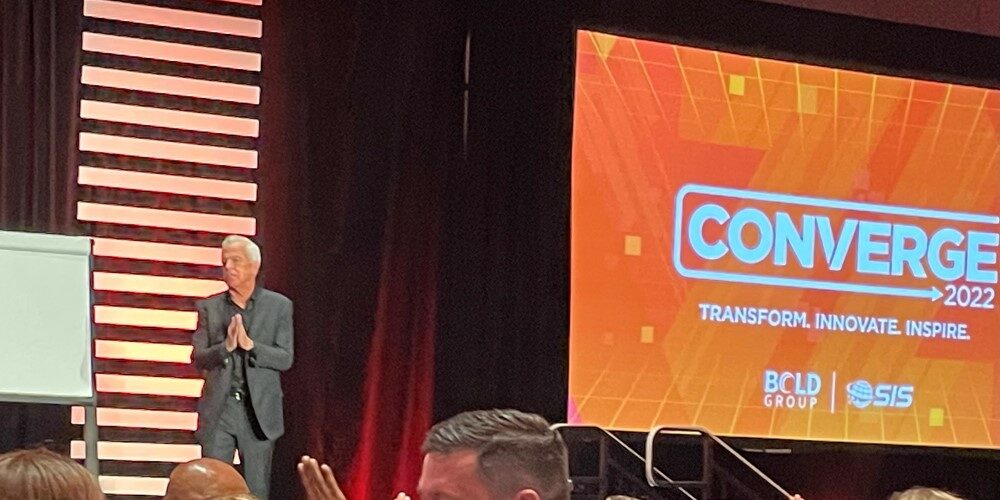Bold Converge Conference Reveals What Security Providers Want
Two major themes were on display at Bold’s 2022 conference: integrating everything with everything and controlling the customer experience.

Keynote speaker Mike Staver opened day two of Converge 2022. (Image: Bold Group | Twitter)
Last month, I was able to attend the Bold Converge Conference in Florida. Normally, Bold has held two different meetings: one for accounting and the other for monitoring automation. However, this year they decided to combine the two disciplines and have one event with different tracks.
Thanks to COVID, for the better part of the last two years we have all been isolated and spending a lot of time on video calls, dealing with mountains of emails and paperwork with very little time to have face-to-face interactions.
Previous to this event, we attended ISC West and a few smaller events. While ISC West was a well-attended event, it’s usually too rushed to have any deep meaningful conversations. Converge has really been the first industry event where there was time to network and to listen to what security service providers have to say and be able to articulate in person what their wants and needs are.
These conversations are the ones where you are sitting down for a meal or adult beverage and you really have time to listen. I am going to say that again, time to listen, not time to make your best pitch — just time to keep quiet and really listen to what they have to say.
Everyone that knows me understands I do know how to speak, in fact, I did or participated in five sessions at the Converge event, but I get so much more out of trying to hear everything people have to say. In my mind, while they are talking I am contemplating how to solve or reduce their concerns and if asked will respond, but this trip I was pretty committed to listening.
What I came away from this event with was an extremely different and new set of needs. Typically, in the monitoring world you come back with a list of requested supported panels, video cameras, or new ways to communicate with subscribers. There was some of this and these are important things to listen for, but at this event, most were secondary asks and wants.
As I said before, this was a combined event, so you have people there that were interested in both accounting and operations, but also monitoring with both groups asking and needing the same things. Perhaps Converge was a good event name after all. For during this event most conversations were all about two themes. The first theme was about integrating everything with everything, the second theme was all about the customer experience. While I embraced both ideas a long time ago, this really was the first time I have heard it so loud and consistent.
I believe this shift into really wanting and needing to fundamentally change how security system providers do business has a direct relationship to the impact of COVID. We have customers that want and need new features and we also have a huge labor shortage that we must compensate for. We are also on the heels of the largest cellular sunset which has strained many operations for the last year, much more than I think most anticipated.
Here is what I consistently heard about these two themes and where I think most will have to get to over the next year or so. If they don’t, I believe they put themselves at risk of becoming obsolete pretty fast.
Integration is defined as “the action or process of combining two or more things in an effective way.” This is a pretty broad representation, but if you start thinking about all the different processes that go on in a security provider’s operation there are likely dozens of platforms, systems, programs or things that you use every day. What providers are looking for is to take these disparate things and link them all together so they behave as one. This needs to be done for a number of reasons, but at the top is labor saving and accuracy.
One very simple example would be a new account is coming online — one that would have started in a company CRM as a sales lead. The address and phone information would have been gathered, then it would have been converted into a contract where all the initial information would just flow into the contract process. When the customer accepted the contract, they would have been required to enter things like passwords, call lists, etc. into the online contract process and that data would flow into the monitoring center’s automation.
When the system is installed, it’s likely programed or at least verified in some kind of downloading or programming tool which would flow things like zones and alarm users into monitoring automation. Customer facing applications would allow the subscriber to make changes to billing information, call lists, passwords, zone names, etc. and all that information would flow upstream automatically to the CRM, billing platform and the monitoring platform.
This is just one very small example of what integrations can do, but if you start to think about every system you use or touch and how significant the number of duplicate efforts there are, you will quickly see just how much low hanging fruit is there to save time and to enhance data reliability.
The next theme I heard consistently over and over is that security providers want desperately to control the customer experience. They are finally recognizing that their customers are all individual and as such want to be able to have security delivered to them the way they want or expect it. No longer is it acceptable to have a “one size fits all” standardized SOP.
We all can appreciate that platforms like alarm automation systems have always been flexible in how they are can do a lot of different things — how they notify, who they call, how they call, when they call or notify, etc. Those systems have been able to be incredibly flexible and continue to get more and more so every year, but what hasn’t changed at all for the most part is functionally, how it gets set up.
Today, most providers have a default way of doing things. That default applies to a group of accounts and that group of accounts will get very consistent results. Where it gets complicated is when one of those individual accounts wants something special. When that happens, it will require someone to manually go and make that change to the individual account.
Where everyone wants to go is to allow the subscriber to be in control of that and be able to make changes on SOP on the fly anytime they want to. For this to happen, integrations like I wrote about earlier must allow this type of change, and in many platforms it works that way. Allowing subscribers to pick their own customer experience is quickly becoming a market differentiator.
The good news for both of these themes is that if you use the right software and service providers you can achieve success. Not all providers or software packages can make this a reality, so really do your homework. If you do, you will not only see incredible operational efficiencies, but more importantly you will see a much happier subscriber base with a lower churn rate and your company will be more valuable in the long run.
If you enjoyed this article and want to receive more valuable industry content like this, click here to sign up for our FREE digital newsletters!

Security Is Our Business, Too
For professionals who recommend, buy and install all types of electronic security equipment, a free subscription to Commercial Integrator + Security Sales & Integration is like having a consultant on call. You’ll find an ideal balance of technology and business coverage, with installation tips and techniques for products and updates on how to add to your bottom line.
A FREE subscription to the top resource for security and integration industry will prove to be invaluable.








